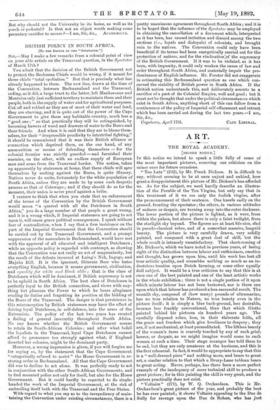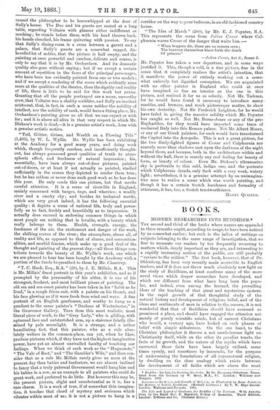ART.
THE ROYAL ACADEMY.
[SECOND NOTICE.] IN this notice we intend to speak a little fully of some of the most important pictures, reserving our criticism on tlie. minor ones for future occasions.
" Too Late " (232), by Mr. Frank Dicksee. It is. difficult to say, without seeming to be at once unjust and unkind, how great a disappointment this picture of Mr. Dicksee's has afforded) us. As for the subject, we need hardly describe an illustra- tion of the Parable of the Ten Virgins, but only say that in this treatment of it we see only the foolish virgins, after the pronouncement of their sentence. One kneels .sadly on the ground, fronting the spectator ; the others, in various attitudes- of sadness or despair, are turning away into the outer darkness. The lower portion of the picture is lighted, as it were, from within the palace, but above there is only a faint twilight, from the starlight sky beyond. The figures are at least life-size, ()lad in pseudo-classical robes, and of a somewhat massive, languid beauty. The picture is very carefully drawn, very solidly painted, and composed with a great deal of skill, but the whole result is intensely unsatisfactory. That short-coming of Mr. Dicksee's, which we have noted in previous years, of losing . sight of the distinction between labour and enthusiasm, emotion and thought, has grown upon him, until his work has lost all true artistic quality, and resembles nothing so much as an in- dustrious treatise upon Dutch farming, or some other equally dull subject. It would be a true criticism to say that this is at once one of the best painted and one of the least artistic works in the whole exhibition ;. there is not a single portion of it upon which minute labour has not been bestowed, nor is there one upon which that labour has produced a less successful result. The moonlit sky, composed of (how many) pounds of ultramarine,. has no true relation to Nature, no true beauty even in the picture itself ; it is simply a blue back-ground, less desirable, because less frankly conventional, than that which Giotto painted behind his pictures six hundred years ago. The carefully disposed robes, lose, in their elaborate folds,, the grace and freedom which give loveliness to drapery ; they are, if not mechanical, at least premeditated. The lifeless beauty of the women's faces is scarcely touched by any of such grief, horror, or despair, as we might imagine would come to such women at such a time. Their stage manager has told them to be sad, but they are only amateurs at the business, and this is the first rehearsal. In fact, it would be appropriate to say that this is a " well-dressed piece " and nothing more, and bears to great art, a similar relation to that which a Drury-Lane tableau bears to great acting. Never, perhaps, has there been a more perfect example of the inadequacy of mere technical skill to produce a great picture ; for in this painting the skill is very great, and the picture practically does not exist.
" Voltaire" (271), by W. Q. Orchardson. This is Mr. Orchardson's great picture of the year, and probably the best he has ever painted; it shows Voltaire appealing to the Due de Sully for revenge upon the Duc de Rohan, who has just
caused the philosopher to be horsewhipped at the door of Sully's house. The Due and his guests are seated at a long table, regarding Voltaire with glances either indifferent or mocking ; he stands before them, with his head thrown back, his hands clenched, his frame quivering with passion. To say that Sully's dining-room is a cross between a garret and a palace, that Sully's guests are a somewhat ragged, dis- hevelled lot of nobles, that the picture is half empty, and the painting at once powerful and careless, delicate and coarse, is only to say that it is by Mr. Orchardson. And its dramatic quality also goes without saying ; but if we except a certain amount of repetition in the faces of the principal personages, who have been too evidently painted from one or two models ; and if we accept a rendering of the scene which evidently aims more at the qualities of the theatre, than the dignity and reality of life, there is little to be said for this work but praise. Granting that all the people portrayed are a mean, unworthy crew, that Voltaire was a shabby scribbler, and Sully an insolent aristocrat, that, in fact, in such a scene neither the nobility of intellect, nor the nobility of rank, would have a fitting place, Mr. Orchardson's painting gives us all that we can expect or wish for; and it is above all alive in that very respect in which Mr. Dicksee's work is dead,—it is a genuine artist's work, done with a genuine artistic motive.
"Toil, Glitter, Grime, and Wealth on a Flowing Tide" (1,493), by W. L. Wyllie. Mr. Wyllie has been exhibiting at the Academy for a good many years, and doing work which, though frequently careless, and insufficiently thought- out, has always possessed great qualities of truth to atmo- spheric effect, and freshness of natural impression ; his, essentially, have been always out-of-door pictures, painted out-of-doors, or at least if not actually so painted, studied sufficiently in the scenes they depicted to render them true ; but he has seldom or never done such good work as he has done this year. He only sends this one picture, but that merits careful attention. It is a scene of river-life in England, mainly concerned with barges, tugs, and wherries; a muddy river and a smoky sky; and besides its technical merits, which arc very great indeed, it has the following essential quality : it depicts a scene of national life, truly and power- fully as to fact, freshly and beautifully as to impression. It actually does succeed in endowing common things in which most people see nothing that is lovable, with a beauty which really belongs to them. Health, strength, energy, the freshness of the air, the excitement and danger of the work, the shifting scenes of the river ; the atmosphere, above all, of reality and life, as opposed to that of shams, and convention- alities, and morbid fancies, which make up a good deal of the thought and painting of the present day,—all these things con- tribute towards the beauty of Mr. Wyllie's work, one which we are pleased to hear has been bought by the Academy with a portion of the funds bequeathed to them by Mr. Chantrey.
"T. C. Hook, Esq., R.A. " (29), by J. E. Millais, R.A. This is Mr. Millais' finest portrait in this year's exhibition, and as if prompted by the personality of his sitter, it is one of his strongest, freshest, and most brilliant pieces of painting. The old sea and sea-coast painter has been taken in his "habit as he lived," in a rough frieze suit, with a palette on his thumb, and his face glowing as if it were fresh from wind and wave. A fine portrait of an English gentleman, and worthy to hang as a pendant to the same painter's "Duchess of Westminster," in the Grosvenor Gallery. Turn from this most realistic, most literal piece of work, to the "Grey Lady," who is gliding, with upturned face and outstretched arm, up a staircase faintly illu- mined by pale moonlight. It is a strange, and a rather humiliating fact, that this painter, who as a rule abso- lutely welters in the common-place, can yet, when he likes, produce pictures which, if they have not the highest imaginative power, have yet an almost unrivalled faculty of touching our feelings. When we think of such work as the "Huguenots," "The Vale of Rest," and "The Gambler's Wife," and then con- sider that as a rule Mr. Millais rarely gives us more at the present day than babies and beefeaters, we are almost inclined to fancy that a truly paternal Government would hang him and his babies in a row, as an example to all painters who could do great work, and preferred to do little. But however this may be, the present picture, slight and unsubstantial as it is, has a rare charm. It is a work of tree, if of somewhat thin imagina- tion, it touches that chord of mystery and eerieness which vibrates within most of us; it is not a picture to hang in a
corridor on the way to your bedroom, in an old-fashioned country house.
" The Ides of March " (260), by Mr. E. J. Poynter, R.A. This represents the scene from' Julius Ccesar where Cal- phurnia warns Cesar of the danger that waits him :- " When beggars die, there are no comets seen ;
The heavens themselves blaze forth the death Of princes."
Cesar, Act ii., Scene 2.
Mr. Poynter has taken a new departure, and in some ways justified it. This, though a cold, is a fine picture, fine in the sense that it completely realises the artist's intention, that it manifests the power of entirely working out a some- what unlovely but dignified conception. We are acquainted with no other painter in England who could at once have imagined so fine an interior as the one in this picture, and realised it for us so soberly. Not Mr. Tadema, for he would have found it necessary to introduce many - marbles, and bronzes, and much picturesque matter, to show his own dexterity. Not Sir Frederick Leighton, for he would have failed in giving the massive solidity which Mr. Poynter has caught so well. Not Mr. Burne-Jones or any of the pre- Raphaelites, for they would have imported some trace of mediaeval Italy into this Roman palace. Not Mr. Albert Moore, or any of our Greek painters, for such would have transformed the Capitol into the Acropolis. This is not a great picture, for the two dimly-lighted figures of Caisar and Calphurnia are scarcely more than shadows cast upon the darkness of the night beyond them, and because, both in the architecture "within and without the hall, there is scarely any real feeling for beauty of form, or beauty of colour. Even Mr. Dicksee's ultramarine sky is preferable to this cold, indigo one, and the- portents which Calphurnia dreads, only flash with a very weak, watery light ; nevertheless, it is a genuine attempt by an unimagina- tive man to realise a scene which was worth painting, aril though it has a certain Scotch harshness and formality of utterance, it has, too, a Scotch trustworthiness.
HAnar QUILTER.



































 Previous page
Previous page